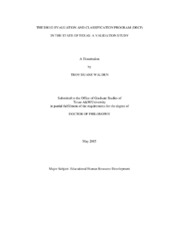| dc.description.abstract | A retrospective research study was conducted to determine the effectiveness of the Drug Evaluation and Classification Program (DECP) procedures in order to identify subjects under the influence of specific drug categories. The investigator wanted to determine if the procedures are reliable and whether a drug recognition expert (DRE) can properly apply the DECP procedures to consistently identify the drug category and have that opinion supported by toxicology.
A total of 324 enforcement drug influence evaluations (DIEs) were obtained from the DRE data tracking system (DRE-DTS) that is maintained through the National Highway Traffic Safety Administration (NHTSA). Toxicology results related to each DIE were compared to the DRE??s drug category prediction.
The objectives of the study were to determine if the 12-step DECP process enables DREs to identify drug categories and those most frequently identified and confirmed in Texas.
Using the DECP, the DRE??s ability to identify specific drugs according to categories and to have the identification supported by toxicology was moderately accurate at best. Of the 324 evaluations that had toxicology results, the DRE correctly identified drug categories as follows: depressants, 60.5%; stimulants, 32%; hallucinogens, 12%; PCP, 46.6%; narcotic analgesics, 51.6%; inhalants, 14.2%; and cannabis, 64.9%.
To determine which drug categories were called most frequently, the enforcement DIEs were analyzed according to each specific category. The investigator found the following drug categories were most frequently called by DREs who evaluated subjects: depressants, 182; cannabis, 142; narcotic analgesics, 83; stimulants, 62; PCP, 18; inhalants, 4; and hallucinogens, 1.
To determine which drug categories were most frequently confirmed through toxicology, the enforcement DIEs were analyzed for the number of confirmations for each specific drug category. The investigator found the following drug categories were most frequently confirmed through toxicology: depressants, 176; cannabis, 140; stimulants, 106; narcotic analgesics, 99; PCP, 26; hallucinogens, 8; and inhalants, 4.
The investigator was able to determine, based on the DRE-DTS data, that Texas DREs are only moderately accurate in identifying drug categories when utilizing the DECP procedures in enforcement settings. Furthermore, the DRE??s prediction of drug category was not consistently supported by toxicology results obtained from evaluated subjects. | en |


